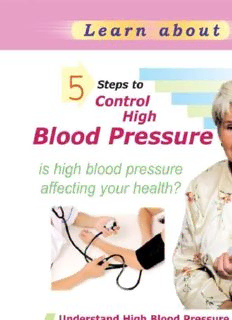
5 Steps to Control High Blood Pressure PDF
Preview 5 Steps to Control High Blood Pressure
Copyright STERLING PAPERBACKS An imprint of Sterling Publishers (P) Ltd. A-59, Okhla Industrial Area, Phase-II, New Delhi-110020. Tel: 26387070, 26386209; Fax: 91-11-26383788 E-mail: [email protected] [email protected] www.sterlingpublishers.com 5 Steps to Control High Blood Pressure © 2007, Dr. Anjali Arora ISBN 978-81-207-3242-1 All rights are reserved. No part of this publication may be reproduced, stored in a retrieval system or transmitted, in any form or by any means, mechanical, photocopying, recording or otherwise, without prior written permission of the authors. The author and publisher specifically disclaim any liability, loss or risk, whatsoever, personal or otherwise, which is incurred as a consequence, directly or indirectly of the use and application of any of the contents of this book. The author wishes to thank all academicians, scientists and writers who have been a source of inspiration. Introduction B lood pressure is the force created as the heart pumps blood through he blood vessels. When the blood pressure goes beyond the prescribed ormal range, an individual is diagnosed as having high blood pressure. High blood pressure (Hypertension) usually shows no symptoms and can affect people of all ages and backgrounds. 25% of the population these days suffer from high blood pressure. You too might be having high blood pressure, and not even know about it! 01. Test Yourself For Possible High Blood Pressure Yes No Lifestyle You have irregular working hours. You are constantly under a lot of stress. You do not have much physical activity at work or at home. No Eating Habits Yes You are fond of salty, fried or sweet food. You have more than two alcoholic drinks each day. You usually have more than two cups of coffee or other caffeinated beverages each day. No Personal and Family History Yes You smoke. You are between 35-50 years of age. You have a close blood relative who suffers from high blood pressure, heart disease or troke. No Medical History Yes Your cholesterol level is over 200 mg/dl. You are more than ten percent of your ideal weight. It has been more than one year since you had your blood pressure checked. The more times you answer “yes” to the above statements, the greater is your risk of developing high blood pressure. 02. Understand High Blood Pressure Understand High Blood Pressure Everyone needs blood pressure (BP) to live. However, high blood pressure is a silent killer. Learn about it and fight this silent threat. 01. The Heart: A Silent Pump The heart is a fist-sized muscle which pumps blood, three hundred and sixty-five days a year, twentyfour hours a day. Your heart pumps away constantly, sending oxygen and nutrient-rich blood through your body. 02. Blood Vessels: Pipelines For Blood Your blood vessels are a network of elastic, smoothly lined ‘pipes’ surrounded by muscles and nerves. Arteries are vessels that carry fresh blood from your heart to your body. Veins return used blood from your body and heart to your lungs. Used blood depleted of oxygen and nutrients, arrives from the upper and lower parts of your body through the blood vessels to the right chamber of your heart. Your heart pumps the used blood through the pulmonary artery to the lungs, where the blood receives fresh oxygen supply (which you breathe in) and gives out carbon dioxide (which you breathe out). Fresh blood, rich in oxygen, returns to the left chamber of your heart from your lungs. This blood gets circulated through the aorta and the other blood vessels to the rest of your body. Arteries supply your heart (coronary arteries) with oxygen rich blood. This makes the heart muscle in the body with its own supply of oxygen and energy. 03. Normal Blood Pressure Blood pressure is the pressure that blood exerts on the walls of the arteries. Measurement of blood pressure consists of two numbers such as 120/80. The first number refers to the systolic pressure and the second to the diastolic. These numbers measure your heart in its pumping and resting stages. Systolic blood pressure: The first number above measures the force while your heart is at the pumping stage. A normal, healthy systolic blood pressure is 120 mmHg or below. Diastolic blood pressure: The second number measures the force at rest - that is, in between the heart pumps. A normal, healthy diastolic blood pressure is 80 mmHg or below. While your diastolic blood pressure stays at about the same level all the time, your systolic blood pressure changes frequently. These variations can be due to your daily activities and the body’s response to physical and mental stress. For example, if your BP is normally 122/80 mmHg at work, it can increase to 160/80 mmHg due to stress. At play, it may also vary from 110/80 mmHg to 150/ 80 mmHg. Regulation of Blood Pressure Regulation of blood pressure through mechanisms which have been well understood are: Baroreceptor reflex: Baroreceptors in various organs can detect changes in blood pressure, and adjust the mean arterial pressure by altering both the force and speed of the heart’s contractions. The total peripheral resistance is also regulated by them. Renin Angiotensin System (RAS): This system is generally known for its long-term adjustment of blood pressure. This system allows the kidney to compensate for the loss in blood volume, in case of surgery or injury. Aldosterone release: This steroid hormone is released from the adrenal cortex in response to angiotensin II or high sodium potassium levels. Aldosterone stimulates sodium retention and potassium excretion by the kidneys. Sodium is the main ion determining the amount of fluid in the blood vessels by osmosis, therefore aldosterone increases the fluid
Description: